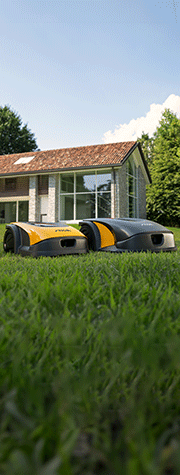
By following our simple tips when storing your gardening tools this winter you can ensure that they are in tip-top condition for the arrival of spring. Here are are tips for cleaning and storing your tools correctly during winter.
How to clean garden tools before winter storage
Don’t forget to clean your tools before storing them. Organic residues, water, and moisture combined with cold temperatures could damage product components, including electrical and mechanical parts.
1. Drain the tanks
Whether it is fuel from an internal combustion engine or water from a pressure washer, it is important to remove all traces of liquid from the tanks of your tools.
2. Remove organic residues
With the help of a brush, remove grass and soil residues, especially from mechanical parts, such as lawn mower blades. It is also good idea to refer to the user manual of your tool for cleaning advice. Remember to also empty and clean grass bags and grass catchers.
3. Remove rust
If you notice rust stains, remove them gently using wire wool and fine sandpaper and cleaning down.
4. Clean plastic and rubber parts
Use a soft-bristled brush to gently clean all plastic and rubber surfaces using soap and water. When cleaning battery-powered tools, use a slightly damp cloth, taking care that moisture does not penetrate into or near the battery housing.
5. Rinse and dry
After cleaning, dry or ensure that all components of machinery are fully dry.
How to carry out proper maintenance
1. Component Check
Check if your tools are intact and all parts are functioning correctly. Regular checks and general maintenance help to improve your tool's efficiency and prolong its life.
Inspect screws, cables, and seals, and look out for corrosion, cracks, or loose parts. If you need spare parts, STIGA offers a complete range of genuine accessories. These can be ordered online or via your local STIGA dealer.
2. Oil mechanical parts
To prevent rust and corrosion it is essential to lubricate the metal parts of your tools, especially the blades. To do this you can use general-purpose mineral oil, such as STIGA oil.
3. Sharpen your cutting tools
When you start gardening again in spring, you will need to make sure that your cutting tools offer precise and clean cuts. Take some time to sharpen the blades of shears, lawnmower blades, robot blades, and other cutting tools. A sharp blade improves performance and reduces plant trauma, resulting in healthier growth.
4. Battery Maintenance
Disconnect the batteries of your cordless tools, charge them fully, and store them in a dry place, preferably at a temperature between 10 and 20°C.

How and where to store garden tools in winter
Choose the right place
Store our garden tools in a warm, dry place, such as a garage or a garden shed. The important thing is that they are protected from water and humidity, in a location protected from frost but also from the sun. If you use covers to protect your larger machines, choose a waterproof cotton model instead of a plastic one that could trap moisture. For smaller instruments use the cases provided instead.
Protect blades
Wrap the blades of lawn mowers, brush cutters, and chainsaw chains in an old towel, this will help absorb moisture and also protect them from accidental damage.
A comfortable rest to be ready for the new season
Thanks to these simple suggestions, your gardening tools will be protected in winter and be ready for the new season come spring!


 Free Delivery
Free Delivery White glove service
White glove service Payments
Payments